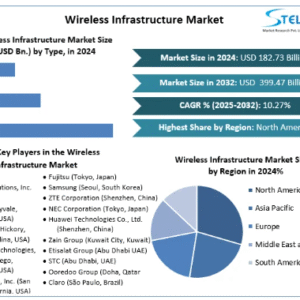E-Commerce International Market was valued at USD 30.52 Trillion. in the year 2024 and is expected to reach USD 294.06 Trillion. by 2032 with a growing CAGR of 32.73% over the forecast period of 2025-2032.
Market Estimation & Definition
The International E-Commerce sector refers to the online exchange of goods and services across national borders, encompassing models such as B2B (business-to-business), B2C (business-to-consumer), C2C (consumer-to-consumer), and even B2G/G2B (business-to-government and government-to-business).
This global market empowers individuals and businesses to access an unparalleled range of products, competitive prices, and innovative solutions, breaking down the limitations of geographical boundaries. The explosive forecast growth reflects increasing digital adoption, improved logistics, and maturing payment ecosystems worldwide.
Market Growth Drivers & Opportunities
Key Growth Drivers
-
Immersive Shopping with AR & VR
Augmented Reality (AR) and Virtual Reality (VR) are transforming the customer journey, offering experiences like virtual try-ons and 3D product previews. These innovations reduce return rates, boost customer engagement, and accelerate buying decisions. -
Mobile Commerce (M-commerce)
With smartphone penetration reaching record highs, mobile devices have become the preferred medium for shopping. Seamless mobile payment systems such as Apple Pay, Google Wallet, Alipay, and WeChat Pay enhance convenience and broaden access to international markets. -
Cybersecurity & Data-Driven Commerce
E-commerce success hinges on consumer trust. Platforms investing in advanced security protocols, fraud prevention systems, and compliance with international data privacy regulations are well-positioned to capture loyal audiences. Data analytics for personalization, recommendation engines, and optimized supply chains are accelerating sales and retention.
Emerging Opportunities
-
Mobile-First Strategies
Businesses prioritizing mobile user experience, speed, and simplified checkout are outperforming competitors, especially in emerging markets where mobile is the primary internet access point. -
Global Trust Leadership
By embedding secure payment systems, transparent return policies, and robust customer support, companies can distinguish themselves in an increasingly crowded marketplace. -
Personalization at Scale
Leveraging AI-driven analytics to adapt offerings in real time—customizing everything from product recommendations to pricing—presents a significant competitive edge.
Segmentation Analysis
By Product Category
-
Home Appliances dominated the market in 2024, fueled by the growing trend of purchasing large and small household electronics online. Enhanced online cataloging, product comparison tools, and home delivery have made this segment particularly strong.
-
Other segments include Books, Cosmetics, Groceries, Apparel, Footwear & Accessories, and Others. While these categories show healthy growth, Home Appliances currently lead in revenue contribution.
By Type of Transaction
-
B2B (Business-to-Business) transactions held the largest market share in 2024. This dominance is attributed to integrated supply chain systems, ERP/CRM connections, and the efficiency of cross-border wholesale commerce.
-
B2C (Business-to-Consumer) is the fastest-growing category, fueled by social commerce trends, influencer-driven shopping, and the increasing purchasing power of digital-native consumers.
Country-Level Analysis: United States & Germany
United States
As part of the North American market, the U.S. continues to lead in e-commerce adoption, driven by a combination of advanced infrastructure, established trust in online transactions, and high mobile device usage. Dominant platforms such as Amazon have set the benchmark for delivery speed, customer service, and personalization.
Germany
Within Europe, Germany remains one of the strongest contributors to the region’s e-commerce growth, supported by efficient logistics, consumer preference for convenience, and a well-developed regulatory framework. Popular categories include fashion, electronics, and household goods, with mobile commerce adoption steadily increasing.
Commutator (Porter’s Five Forces) Analysis
-
Threat of New Entrants: Moderate. While technological and regulatory barriers deter casual entrants, niche startups in social commerce and specialty goods still emerge rapidly.
-
Bargaining Power of Suppliers: Variable. Global giants like Amazon or Alibaba maintain high leverage over suppliers, while smaller platforms must negotiate more strategically.
-
Bargaining Power of Buyers: High. Consumers benefit from global price transparency, broad product choice, and competitive delivery options.
-
Threat of Substitutes: Medium. Traditional retail remains a substitute, but convenience, variety, and pricing advantages are shifting preferences toward e-commerce.
-
Competitive Rivalry: Intense. The market is defined by competition among established players and fast-moving newcomers, each racing to innovate in delivery, personalization, and payment integration.
Conclusion
The global e-commerce international market is on track for a near-tenfold expansion over the next decade, with projections climbing from USD 30.52 trillion in 2024 to USD 294.06 trillion by 2032. This transformation is propelled by the rapid evolution of digital technologies, mobile-first consumer behavior, immersive shopping experiences, and the rising importance of data-driven strategies.
Key insights from the research indicate:
-
Home Appliances lead in product sales, with B2B transactions holding the current market share crown.
-
B2C transactions are poised for explosive growth due to social commerce and younger consumer adoption.
-
Technological advancements like AR/VR, mobile payments, and AI analytics are no longer optional—they’re essential for competitive survival.
-
Developed economies such as the U.S. and Germany remain leaders in infrastructure and innovation, setting global benchmarks in delivery speed, consumer trust, and user experience.
-
Market competition will remain fierce, rewarding only the most agile, customer-centric, and technologically advanced players.
As the decade unfolds, companies that prioritize secure, personalized, and seamless shopping experiences will be best positioned to thrive in this rapidly expanding global arena.
About Stellar Market Research:
Stellar Market Research is a multifaceted market research and consulting company with professionals from several industries. Some of the industries we cover include science and engineering, electronic components, industrial equipment, technology, and communication, cars, and automobiles, chemical products and substances, general merchandise, beverages, personal care, and automated systems. To mention a few, we provide market-verified industry estimations, technical trend analysis, crucial market research, strategic advice, competition analysis, production and demand analysis, and client impact studies.
Contact Stellar Market Research:
S.no.8, h.no. 4-8 Pl.7/4, Kothrud,
Pinnac Memories Fl. No. 3, Kothrud, Pune,
Pune, Maharashtra, 411029
+91 20 6630 3320, +91 9607365656




